I hope this becomes my most popular recipe!
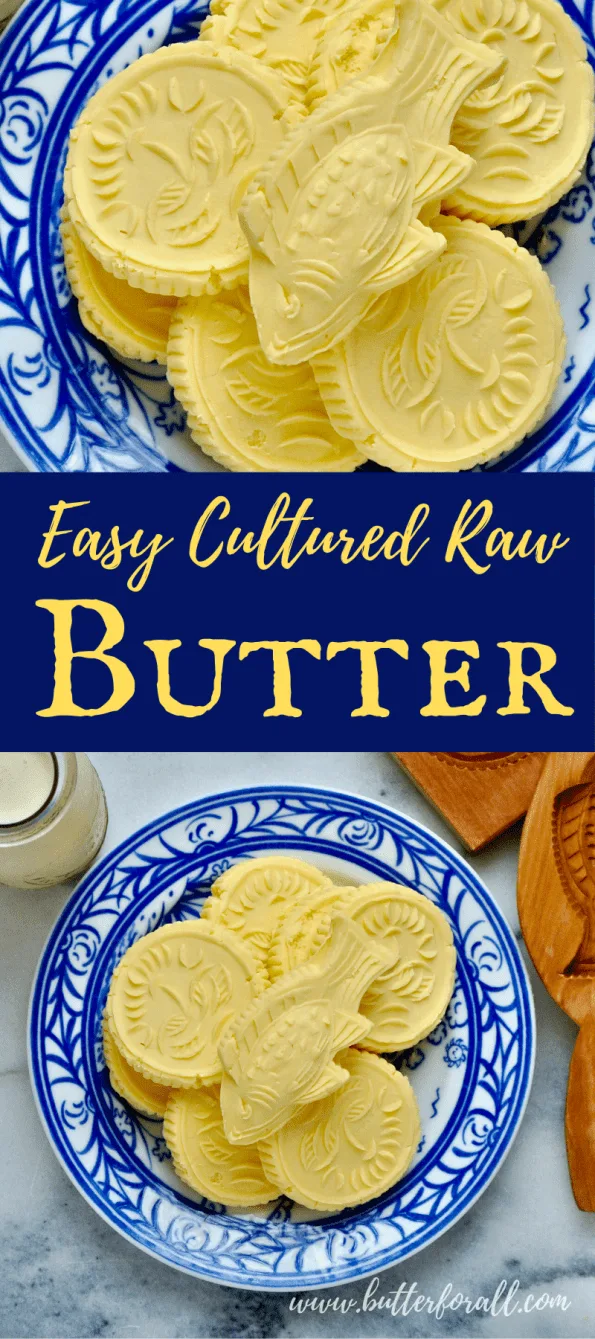
I’m a huge advocate for real butter being incorporated into every meal. Butter is a nourishing traditional food, full of fat-soluble vitamins and essential fatty acids.
The saturated fat in butter also contains cholesterol — one of the most important building blocks for the nervous system, hormones, and the brain. Cholesterol is a precursor to vitamin D (something modern humans need much more of), aids in digestion by producing bile salts, and also does a great job repairing all kinds of damaged cells!
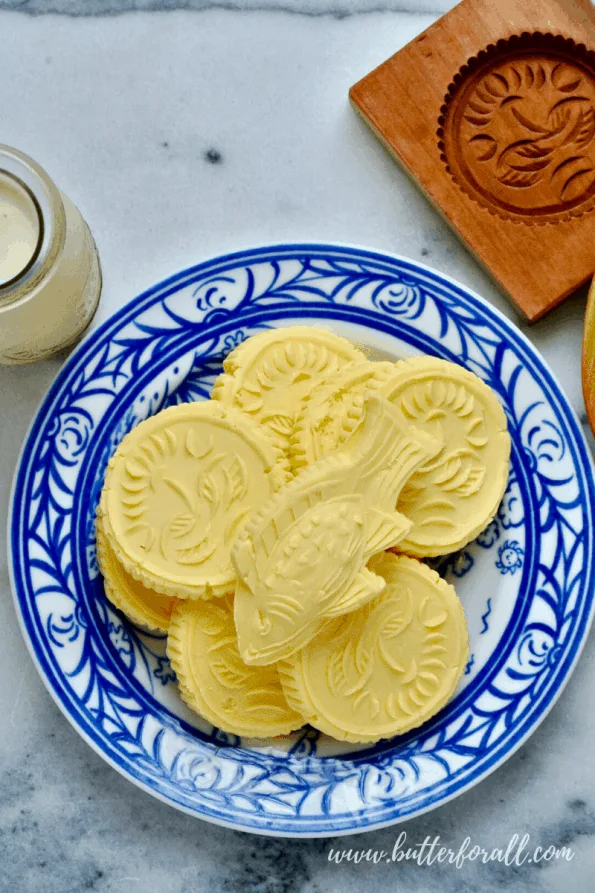
Butter a Superfood?
I think so, and I believe that many health professionals are also awakening to the benefits of a butter-rich diet. Of course it’s important to remember that we must support regenerative farming and humane animal management. So please make sure you are buying or making butter with cream from pasture-raised animals. Cows fed on responsibly managed grassland, in a natural environment with ample sunshine, will have meat, milk, cream, and butter with higher nutrient quantities.
Butter contains vitamins A, D, E, and K2 that protect your heart, joints, and arteries. These vitamins support the absorption of calcium for strong bones and teeth, and they play crucial roles in growth and development.
The fatty acids in butter protect your intestinal tract from infection, help heal the gut wall, protect you from cancer, maintain healthy skin, control weight gain, boost metabolism, support immune function, make you feel good, and aid fertility!
Butter is also a good source of iodine, which plays a crucial role in thyroid function.
These are just some of the reasons to add this superfood into your diet today!
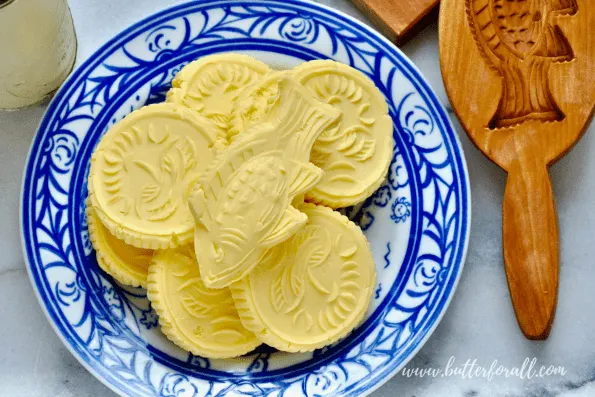
Why Raw Cultured Dairy Is Superior
Culturing dairy has many benefits like improving nutrition, improving digestion, and facilitating natural preservation.
Before the modern advancement (?) of pasteurization, many traditional cultures had some sort of fermented or cultured dairy product. Sour cream, creme fraiche, clabber milk, yogurt, kefir, pima milk, and hard and soft cheeses are all ways of using fermentation to preserve raw unadulterated dairy.
Culturing dairy is a spontaneous action. When left at room temperature the bacteria in raw milk will eventually multiply and create enough lactic acid to sour the milk. When left long enough the acids produced make the milk proteins coagulate and they separate from the acid-containing whey. Naturally soured milk is known as Clabber Milk.
Cultured dairy is easy on the digestive tract and better for your health!
As the milk cultures, much of the lactose is broken down, enzymes that aid in digestion and mineral absorption are increased, beneficial bacteria counts increase, vitamins B and C increase, and proteins become easier to digest.
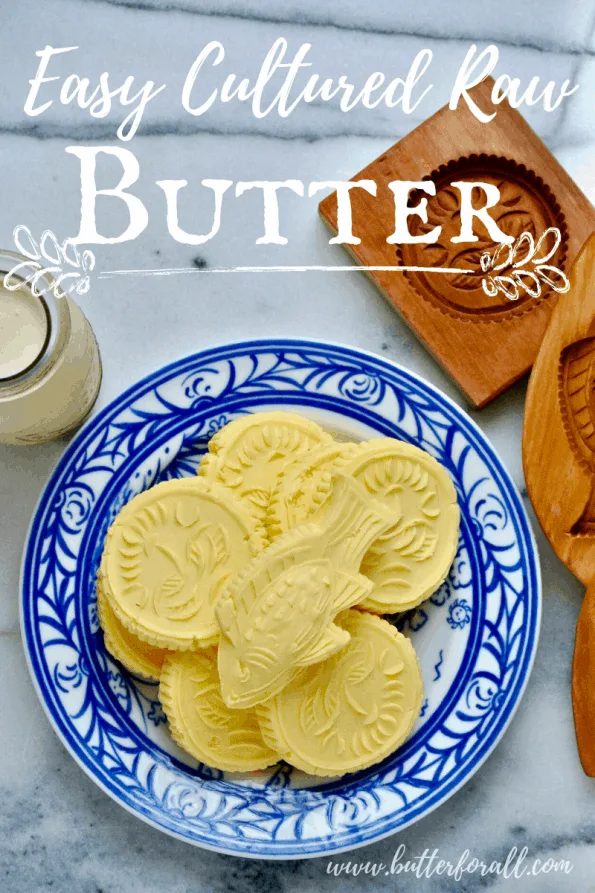
Culturing Raw Cream for Butter
This can be done in several ways.
- You can use the clotted cream from naturally fermented Clabber Milk.
- You can leave your raw cream out at room temperature until it sours itself.
- Or you can use a bit of raw yogurt as a starter for fermentation. This is my preference and gives the most consistent results with a pleasing flavor. The recipe that follows will use this method.
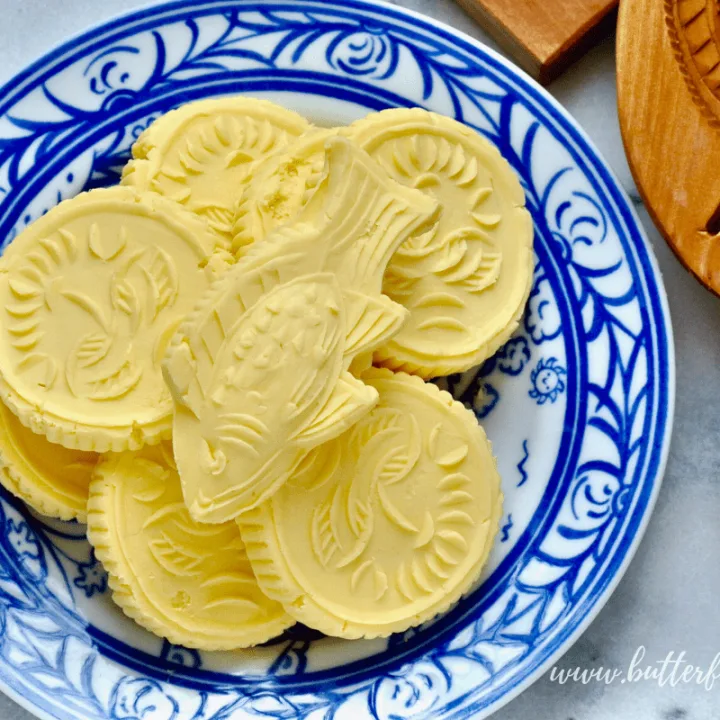
Cultured Raw Butter
Learn how to make the best tasting most healthy butter in the world by culturing raw dairy!
Ingredients
- 1 quart raw cream
- 2 tablespoons raw yogurt
Instructions
- Take a clean wide-mouth quart jar and add fresh raw cream.
- Place the jar in a warm water bath over very low heat.
- When the cream is warm, around 100°F, add the raw yogurt and whisk it well.
- Turn off the heat and leave the cream in the water bath until the water cools completely.
- Leave the cream at room temperature until the cream separates from any solid milk. There will be a clear cream line on the jar and the milk portion (if any) will be yogurt consistency. Do not stir or shake the cream. This takes about 8 to 12 hours so I leave mine out overnight.
- Refrigerate the cream until chilled through.
- Scoop off the cream into a butter churn or mixing bowl with whisk attachment.
- Churn or whip the cream until the fat separates from the buttermilk.
- Pour the cultured buttermilk off and save it for soaking grains or making baked goods.
- Add very cold ice water to the bowl or churn. With cold hands knead the butter in the water, removing any additional buttermilk and washing it away. The kneading action should also press the butter and make it a solid piece without any air bubbles.
- Remove the butter from the churn or bowl and squeeze out any remaining water.
- Place the butter on a clean towel and pat it gently. Don't let it get warm or it will stick!
- With very cold hands kneed the butter for several minutes on a wooden board, wiping away excess water as it is pushed out.
- If adding salt, do so now, 1/2 teaspoon salt to 1 pound of butter. With cold hands kneed the salt right into the butter until it is fully incorporated.
- With cold hands mold or shape the butter and wrap it in parchment paper or store it in an airtight container. Butter can be frozen, refrigerated, or left at room temperature (if you plan on consuming it fairly quickly).
Notes
For cold hands, chill your hands under cold running water until very cold. This is essential to the butter-making process.
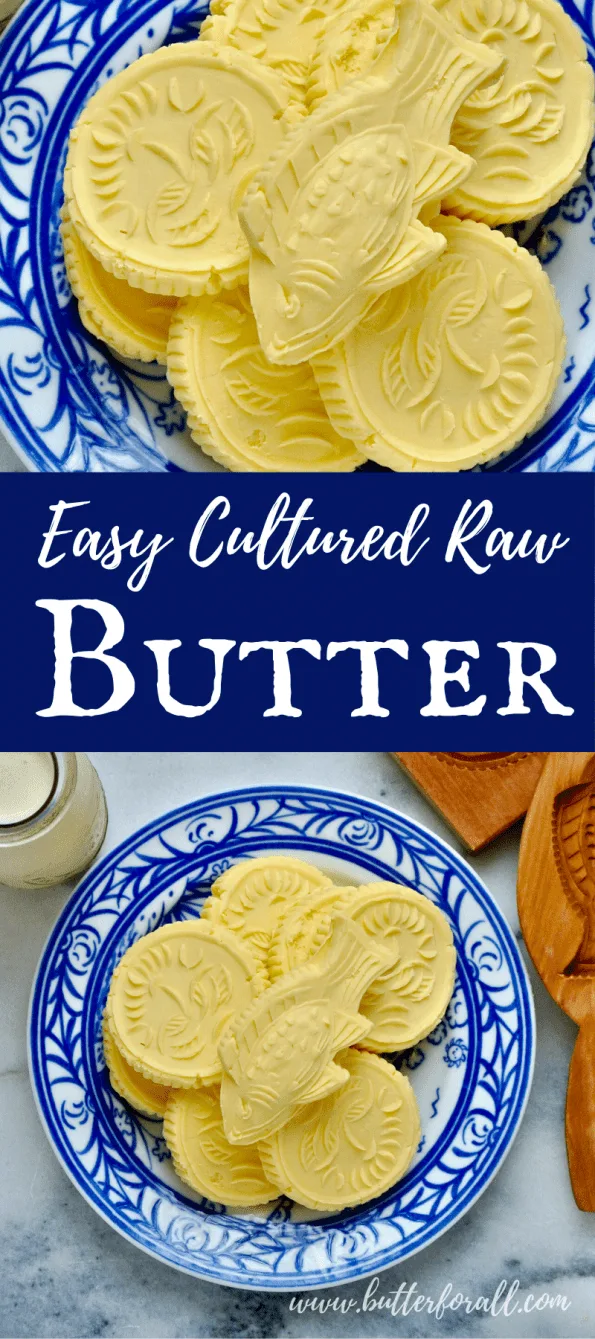
References:
The Weston A. Price Foundation
Fallon, S., & Enig, M. (1999). Nourishing Traditions. Washington, DC: New Trends Publishing Inc.
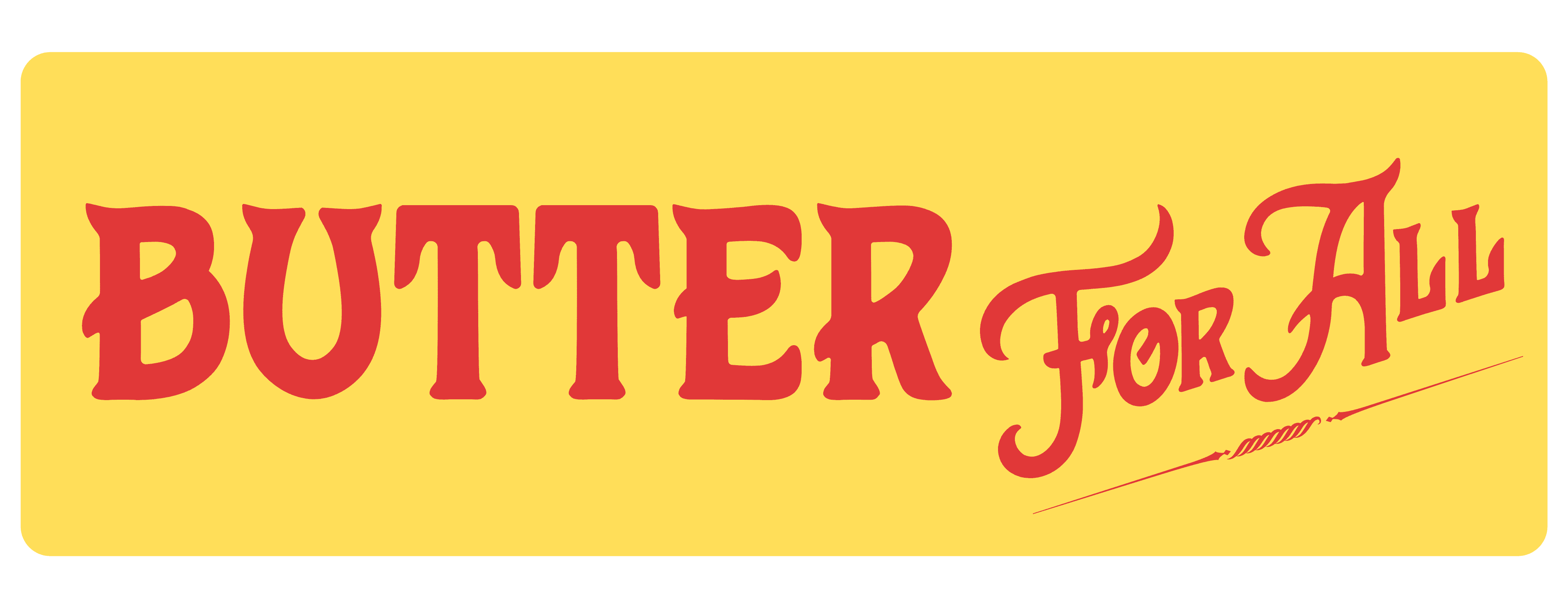
Terry White
Wednesday 9th of August 2023
Sooo, where do you suggest we get "RAW CREAM"? Everything in our local stores is pasteurized or ultra pasteurized.
Butter For All
Saturday 12th of August 2023
Hi Terry,
Hooking up with a local farmer in you area is the best bet. Check out this resource to *hopefully find a producer near you. Real Milk
Vicki
Sunday 14th of May 2023
Wow Thank you Grateful to have found your content
Butter For All
Tuesday 16th of May 2023
Glad you are here. Vicki!
Faith Montoya
Tuesday 25th of January 2022
I absolutely love this! I didn’t even know there was such a thing as cultured butter! I always buy the good grass fed butter but I’m definitely goi g to try this! It will go fabulously on my home made sour dough I make for my family! Thank you!
Butter For All
Friday 28th of January 2022
Hi Faith!
Yes it will! The tang and depth of flavor goes perfectly with sourdough. Enjoy!
Dixie Kieffer
Monday 22nd of June 2020
Where does one purchase raw cream and raw yogurt?
Butter For All
Thursday 25th of June 2020
Hi Dixie!
I have instructions for making the yogurtEasy Raw Cow’s Milk Yogurt, but you will need a source for raw milk. You can use the raw milk finder here if it is not sold in stores in your state or country. If you need more help finding raw milk, reach out to your local chapter of the Weston A. Price Foundation. I hope you can locate some soon,
Courtney
Stephanie Hosey
Sunday 22nd of December 2019
Can the "buttermilk" be cultured once separated, to have thick consistency and nutritious like kefir-ish?
Butter For All
Monday 23rd of December 2019
Hi Stephanie,
The buttermilk is actually already cultured. You can try warming it gently in a water bath at 100º for a few hours to see if it will get thicker and set up. I typically just use it as is for baked goods like pancakes.
Let me know how it goes!
Courtney